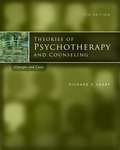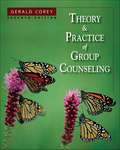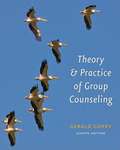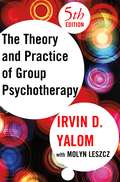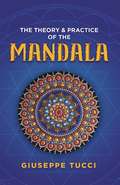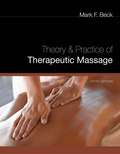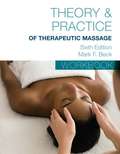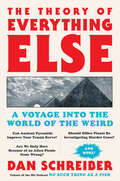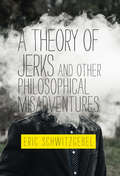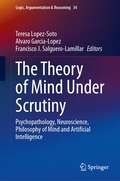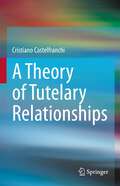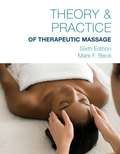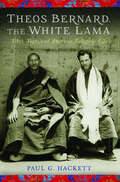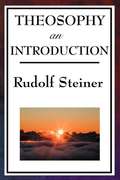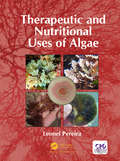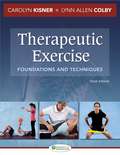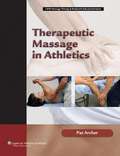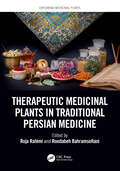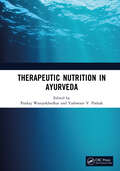- Table View
- List View
Theories of Hypnosis: Current Models and Perspectives
by Steven J. Lynn Judith W. RhueA survey of current theories of hypnosis along with relevant research.
Theories of Illness: World Survey
by George Peter MurdockTheories of Illness establishes a new landmark in comparative studies. Utilizing concepts from modern medicine and anthropological theory, Professor Murdock distinguishes the natural causes of illness from theories of supernatural causation. He subdivides the latter into theories of illness that are related to aggression (witchcraft, sorcery, and spirit aggression) and those which are related to guilt and a sense of sin (taboo violation and mystical retribution). Obviously, these relate to man's most basic beliefs as revealed in early religions.
Theories of Personality
by Lawrence Pervin Daniel Cervone John Oliver"Why should you take a course in personality? Why are some people so taken by the field that they decide to become personality psychologists? A basic attraction of the field is that it addresses the questions "Why are people the way they are? Why am I the way I am?" We are all fascinated by such questions, and personality psychology promises to answer them. Admittedly, this text and the scientific field it reviews may not definitively answer all of your questions. Yet much scientific progress has been made in understanding persons and the differences among them. This book will introduce you to some of the answers that contemporary scientific research can provide, while also introducing you to the best and most influential theoretical frameworks that have been developed for studying people." From Chapter 1
Theories of Psychotherapy and Counseling: Concepts and Cases (Fifth Edition)
by Richard S. SharfComprehensive in scope yet succinct in its descriptions and explanations, THEORIES OF PSYCHOTHERAPY & COUNSELING: CONCEPTS AND CASES, 5e equips readers with a solid understanding of the systematic theories of psychotherapy and counseling. The text delivers a thorough explanation of concepts as well as insightful case summaries and therapist-client dialogue that illustrate techniques and treatment in practice. It demonstrates how theories can be applied to individual therapy or counseling for common psychological disorders--such as depression and generalized anxiety disorders--as well as how to apply them to group therapy.
Theory and Practice of Group Counseling
by Gerald CoreyThis text outlines the basic elements of group process, deals with ethical and professional issues of group work, and overviews the key concepts and techniques of ten approaches to group counseling. This updated sixth edition emphasizes the practical applications of the theoretical models of group work, and encourages students to develop a synthesis of these approaches. There are two new chapters on stages of group development. Corey is professor emeritus of human services at California State University.
Theory and Practice of Group Counseling (8th Edition)
by Gerald CoreyWith the guidance of world-renowned counseling author, teacher, and practitioner Gerald Corey, best-selling Theory and Practice of Group Counseling, 8e equips readers with the knowledge and skills for effective group counseling and leadership. You'll learn key theoretical approaches to group leadership and how to successfully apply each in practice. With Corey's clear, straightforward writing style, you will have no difficulty understanding each theoretical concept and its relationship to group practice. And as you explore different approaches, your growing knowledge will enable you to integrate techniques from the various approaches you'll study in this book to create a unique approach that works successfully for YOU.
The Theory and Practice of Group Psychotherapy, Fifth Edition
by Irvin D. Yalom Molyn LeszczIn this completely revised and updated fifth edition of group psychotherapy’s standard text, Dr. Yalom and his collaborator present the most recent developments in the field, drawing on nearly a decade of new research as well as their broad clinical wisdom and expertise. Among the significant new topics: Online therapy Specialized groups Ethnocultural diversity Trauma Managed care Plus hundreds of new references and clinical vignettes
The Theory and Practice of the Mandala
by Giuseppe TucciMandalas are complex arrangements of patterns or pictures used in Hindu and Buddhist Tantrism to represent the cosmos and to give expression to the infinite possibilities of the human subconscious. Believers rely upon this powerful figure as a focus of ritual and a support for meditations, using it to gain possession of the energies signified by its images or symbols. This intriguing, thought-provoking study by one of the world's leading authorities on the subject examines the basic doctrine behind the theory and practice of the mandala in India and Tibet, by both Hindus and Buddhists. Individual chapters consider the doctrinal basis of the mandala, its various parts, liturgy, and relationship to the human body. Of special interest to students of Eastern philosophy and art, this study will also fascinate New Agers and anyone interested in the symbols and psychology of Asian cultures.
Theory and Practice of Therapeutic Massage (Fifth Edition)
by Mark F. BeckThe Theory and Practice of Therapeutic Massage (5th edition) is the classic text in the massage industry including the essential knowledge and skills needed to become a successful, professional massage therapist, plus the essentials of anatomy and physiology. Essential topics to the industry such as ethics, hygiene, communication skills, and body mechanics are discussed. Full-color illustrations and photographs clearly illustrate techniques and procedures. Classical massage is expanded with clinical techniques including neuromuscular and myofascial techniques, and lymph massage, combined to better serve the client by following therapeutic procedures. Numerous career tracts are explored including massage in a spa environment and athletic massage. A new chapter discusses massage for special populations including pre-natal, infant, elder, critically ill, people with cancer, and hospice. The final chapter has been revised to cover business practices for finding employment or successful self-employment.
Theory And Practice Of Therapeutic Massage Workbook (Sixth Edition)
by Mark F. BeckThis Theory & Practice of Therapeutic Massage Workbook has been written to meet the needs, interests, and abilities of students, like you, receiving training In therapeutic massage. This workbook should be used together with Theory & Practice of Therapeutic Massage, Sixth Edition.
The Theory of Everything Else: A Voyage Into the World of the Weird
by Dan Schreiber"Absorbing. ... As thoughtfully written as it is nuts." —Chicago TribuneA collection of the world’s most mind-boggling, thought-provoking, and downright hilarious theories by the co-host of the hit podcast No Such Thing as a Fish, Dan Schreiber.Why are we here? Do ghosts exist? Will we ever travel back in time? Are we being visited by extraterrestrials? Will we ever talk to animals? Are we being told the truth? Are mysterious creatures roaming the Earth? And why, when you’re in the shower, does the shower curtain always billow in towards you?We don’t know the answers to any of these questions (that includes the shower-curtain one, which is a mystery that has eluded scientists for decades, and which they are still trying to solve). But don’t worry, no matter what questions you have, you can bet on the fact that there is someone (or something) out there, investigating it on your behalf—and Dan Schreiber collects their latest findings.From the Silicon Valley tech billionaires currently trying to work out whether or not the universe is one giant video game simulation to the self-proclaimed community of Italian time-travelers who are trying to save the world from destruction; The Theory of Everything Else will act as a handbook for those who want to think differently.
A Theory of Jerks and Other Philosophical Misadventures (The\mit Press Ser.)
by Eric SchwitzgebelA collection of quirky, entertaining, and reader-friendly short pieces on philosophical topics that range from a theory of jerks to the ethics of ethicists.Have you ever wondered about why some people are jerks? Asked whether your driverless car should kill you so that others may live? Found a robot adorable? Considered the ethics of professional ethicists? Reflected on the philosophy of hair? In this engaging, entertaining, and enlightening book, Eric Schwitzgebel turns a philosopher's eye on these and other burning questions. In a series of quirky and accessible short pieces that cover a mind-boggling variety of philosophical topics, Schwitzgebel offers incisive takes on matters both small (the consciousness of garden snails) and large (time, space, and causation). A common theme might be the ragged edge of the human intellect, where moral or philosophical reflection begins to turn against itself, lost among doubts and improbable conclusions. The history of philosophy is humbling when we see how badly wrong previous thinkers have been, despite their intellectual skills and confidence. (See, for example, “Kant on Killing Bastards, Masturbation, Organ Donation, Homosexuality, Tyrants, Wives, and Servants.”) Some of the texts resist thematic categorization—thoughts on the philosophical implications of dreidels, the diminishing offensiveness of the most profane profanity, and fatherly optimism—but are no less interesting. Schwitzgebel has selected these pieces from the more than one thousand that have appeared since 2006 in various publications and on his popular blog, The Splintered Mind, revising and updating them for this book. Philosophy has never been this much fun.
Theory Of Mind And Science Fiction
by Nicholas O. PaganTheory of Mind and Science Fiction shows how theory of mind provides an exciting 'new' way to think about science fiction and, conversely, how science fiction sheds light not only on theory of mind but also empathy, morality, and the nature of our humanity.
The Theory of Mind Under Scrutiny: Psychopathology, Neuroscience, Philosophy of Mind and Artificial Intelligence (Logic, Argumentation & Reasoning #34)
by Teresa Lopez-Soto Alvaro Garcia-Lopez Francisco J. Salguero-LamillarThis book is a call to expand and diversify our approach to the study of the human mind in relation to the Theory of Mind. It proposes that it is necessary to combine cross-disciplinary methods to arrive at a more complete understanding of how our minds work. Seeking to expand the discussion surrounding the Theory of Mind beyond the field of psychology, and its focus on our capacity to ascribe mental states to other people, this volume collects evidence and research to point to a more holistic understanding of our own minds, the minds of others, behavior, language, and reasoning. This book therefore illuminates the conceptual intricacy underlying the Theory of Mind. It posits that a wide scope is necessary to make a breakthrough in scientific research towards a full understanding of the nature, function, and development of our capacity to converge on biological processes of the brain towards consciousness, emotion, awareness, and cognition. The volume presents methods, results, critiques, and models intended to provoke debates in various academic disciplines. It is of interest to scholars working in psychology, neuroscience, philosophy of mind, and artificial intelligence.
A Theory of Tutelary Relationships
by Cristiano CastelfranchiThe purpose of the book is to propose and exploit an analytical, critical, well defined theory of a very crucial human social relation that I call “Tutelarity/ Tutelage”. This will thus explain how/why such relation is so relevant at any layer of sociality: from affective relationships, to social cooperation and interactions, to politics and democracy. The approach is theoretical and strongly grounded on cognitive science and the models of human mind: beliefs, desires, expectations, emotions, etc. Written in an accessible way, it will be of interest for a large audience, specifically to researchers and scientists interested in cognitive science and the dynamics of social relationships alike.
Theory & Practice of Therapeutic Massage, Sixth Edition
by Mark F. BeckTheory & Practice of Therapeutic Massage is full of invaluable knowledge and fundamental concepts for learning massage. The text also provides introductions into several areas within the profession, with chapters devoted to spa massage, lymph massage, clinical massage techniques, therapeutic procedure, athletic massage, and massage in medicine.
Theos Bernard, the White Lama: Tibet, Yoga, and American Religious Life
by Paul HackettIn 1937, Theos Casimir Bernard (1908–1947), the self-proclaimed "White Lama," became the third American in history to reach Lhasa, the capital city of Tibet. During his stay, he amassed the largest collection of Tibetan texts, art, and artifacts in the Western hemisphere at that time. He also documented, in both still photography and 16mm film, the age-old civilization of Tibet on the eve of its destruction by Chinese Communists. Based on thousands of primary sources and rare archival materials, Theos Bernard, the White Lama recounts the real story behind the purported adventures of this iconic figure and his role in the growth of America's religious counterculture. Over the course of his brief life, Bernard met, associated, and corresponded with the major social, political, and cultural leaders of his day, from the Regent and high politicians of Tibet to saints, scholars, and diplomats of British India, from Charles Lindbergh and Franklin Delano Roosevelt to Gandhi and Nehru. Although hailed as a brilliant pioneer by the media, Bernard also had his flaws. He was an entrepreneur propelled by grandiose schemes, a handsome man who shamelessly used his looks to bounce from rich wife to rich wife in support of his activities, and a master manipulator who concocted his own interpretation of Eastern wisdom to suit his ends. Bernard had a bright future before him, but disappeared in India during the communal violence of the 1947 Partition, never to be seen again.Through diaries, interviews, and previously unstudied documents, Paul G. Hackett shares Bernard's compelling life story, along with his efforts to awaken America's religious counterculture to the unfolding events in India, the Himalayas, and Tibet. Hackett concludes with a detailed geographical and cultural trace of Bernard's Indian and Tibetan journeys, which shed rare light on the explorer's mysterious disappearance.
Theos Bernard, the White Lama: Tibet, Yoga, and American Religious Life
by Paul G. HackettThe life and adventures of an American explorer and iconic figure in the 20th century religious counterculture movement.In 1937, Theos Casimir Bernard, the self-proclaimed &“White Lama,&” became the third American in history to reach Lhasa, the capital city of Tibet. During his stay, he amassed the largest collection of Tibetan texts, art, and artifacts in the Western hemisphere at that time. He also documented, in both still photography and 16mm film, the age-old civilization of Tibet on the eve of its destruction by Chinese Communists. Based on thousands of primary sources and rare archival materials, this is the real story behind the purported adventures of Bernard and his role in the growth of America's religious counterculture. Over the course of his brief life, Bernard met, associated, and corresponded with the major social, political, and cultural leaders of his day, from the Regent and high politicians of Tibet to saints, scholars, and diplomats of British India, from Charles Lindbergh and Franklin Delano Roosevelt to Gandhi and Nehru. Although hailed as a brilliant pioneer by the media, Bernard also had his flaws. He was an entrepreneur propelled by grandiose schemes, a handsome man who shamelessly used his looks to bounce from rich wife to rich wife in support of his activities, and a master manipulator who concocted his own interpretation of Eastern wisdom to suit his ends. Bernard had a bright future before him but disappeared in India during the communal violence of the 1947 Partition, never to be seen again.&“Well-written…A readable intellectual account of the life of an ambitious Tibetological pioneer.&”—Asian Ethnology
Theosophy: An Introduction
by Rudolf SteinerA clear, concise explanation of human nature; the worlds of body, soul, and spirit; the laws of reincarnation; and the workings of karma.
Therapeutic Action: A Guide to Psychoanalytic Therapy
by Enrico E. JonesDiscusses the Q-sort method for quantifying and tracking progress in psychotherapy.
Therapeutic and Nutritional Uses of Algae
by Leonel PereiraAlgae have been used since ancient times as food, fodder, fertilizer and as source of medicine. Nowadays seaweeds represent an unlimited source of the raw materials used in pharmaceutical, food industries, medicine and cosmetics. They are nutritionally valuable as fresh or dried vegetables, or as ingredients in a wide variety of prepared foods. In particular, seaweeds contain significant quantities of protein, lipids, minerals and vitamins. There is limited information about the role of algae and algal metabolites in medicine. Only a few taxa have been studied for their use in medicine. Many traditional cultures report curative powers from selected alga, in particular tropical and subtropical marine forms. This is especially true in the maritime areas of Asia, where the sea plays a significant role in daily activities. Nonetheless, at present, only a few genera and species of algae are involved in aspects of medicine and therapy. Beneficial uses of algae or algal products include those that may mimic specific manifestations of human diseases, production of antibiotic compounds, or improvement of human nutrition in obstetrics, dental research, thallassotherapy, and forensic medicine.
Therapeutic Exercise: Foundations and Techniques (Sixth Edition)
by Carolyn Kisner Lynn Allen ColbyThoroughly revised and updated throughout, Kisner & Colby's 6th Edition offers the most up-to-date exercise guidelines for individualizing interventions for those with movement disorders. Now with contributions from the leading experts in the field, it encompasses all of the principles of therapeutic exercise and manual therapy, including spinal surgery and spinal manipulation. This renowned manual remains the authoritative source for exercise instruction for the therapist and for patient self-management.
Therapeutic Massage in Athletics (Lww Massage Therapy and Bodywork Educational Ser.)
by Pat ArcherThis textbook on sports massage was created specifically for massage therapists, certified athletic trainers, and physical therapists who work with athletes. The author is an experienced massage therapy and athletic training educator and practitioner, and provides instruction on how to apply clinical massage techniques to athletes. The text is uniquely focused on the use and integration of basic sports massage, myofascial, neuromuscular, and lymphatic facilitation to enhance an athlete's performance potential and treat common athletic injuries and conditions. <P><P>The book includes numerous diagrams and pictures of techniques to help readers visualize specific concepts and procedures. From the Field Boxes contain quotes from professionals who practice sports massage. Case Studies present common athletic injury scenarios and descriptions of treatment protocols.
Therapeutic Medicinal Plants in Traditional Persian Medicine (Exploring Medicinal Plants)
by Roja Rahimi Roodabeh BahramsoltaniTraditional Persian Medicine (TPM) is one of the oldest medical doctrines, globally known due to pioneering physicians and scientists. The greatest source of natural medicines in TPM originates from medicinal plants. Therapeutic Medicinal Plants in Traditional Persian Medicine provides a background on the history of TPM, as well as an introduction to 40 of the most popular medicinal plants used in TPM. It is a practical guide for readers interested in medicinal plants used in the prevention, management, and treatment of different diseases.Features: Includes both traditional therapeutic applications and modern evidence/ uses Makes a comparison between preclinical and clinical studies Provides information on major chemical constituents, therapeutic uses, adverse reactions, and safety for each plant species A volume in the “Exploring Medicinal Plants” series, this book is a valuable resource for researchers, students, academicians, and scientists dealing witth medicinal plants, as well as for those interested in the fields of pharmacognosy, naturopathy, phytotherapy, and traditional medicines.
Therapeutic Nutrition in Ayurveda
by Pankaj Wanjarkhedkar Yashwant V. PathakNutrition remains the key to the successful treatment of diseases, in addition to the various evolved medical treatments across the world. The treatment outcome improves to a better extent with a degree of nourishment of the patients. Therapeutic Nutrition in Ayurveda (TNA) categorizes diseases system-wise and discusses nutrition with references from Ayurveda classics as well as publications from indexed journals in today’s world. This book emerges as a pilot project to discuss the clinical experiences directly and the concept of nutravigilance by experienced authors of respective specialties like hepatology, neurology, dermatology, ophthalmology, oncology, cardiology, gynecology, and so on. It broadly discusses diet and nutrition based on 12 different groups of diet in Ayurveda. Nutrition has been widely discussed for every disease dynamically in Ayurveda, with details of exclusion and inclusion of foods over a stipulated period or entire duration of treatment. Key Features: Presents system-wise and disease-wise therapeutic nutrition Includes clinical experience of physicians on therapeutic nutrition Contains interdisciplinary discussion on therapeutic nutrition with an integrated approach The integration of traditional and conventional health systems, along with the multidisciplinary approach, is the emerging trend for inclusive health care in the coming decades. This book serves as a handy guide for health care professionals across the continents, providing interdisciplinary correlations on nutrition.

